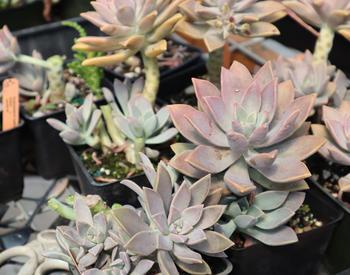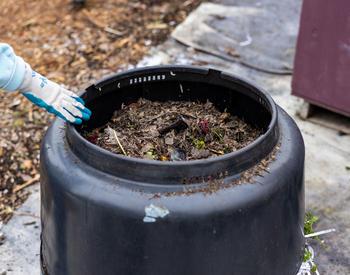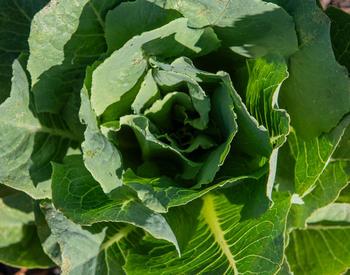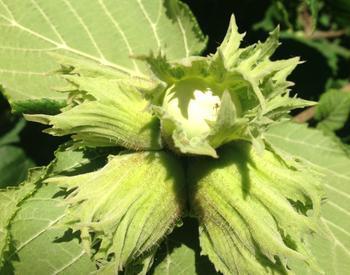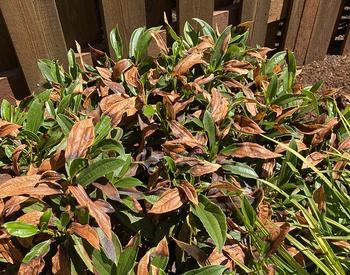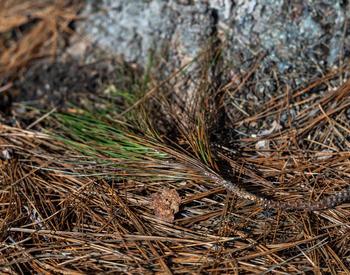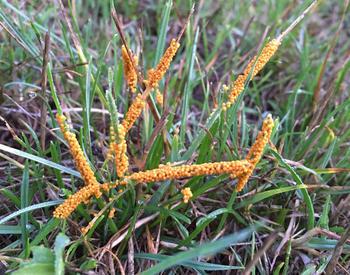Spider mites are common, tiny garden pests, related to spiders and ticks. Usually microscopic, mites can be found in almost any habitat, including the human body. We refer to some mites based on where they are found: cheese mites, dust mites, eyelash mites.
The term “spider mite” is often used to refer to mites that attack plants. For instance in Oregon, spruce mite is a common pest of spruce and a few other trees. The two-spotted spider mite is a spider mite that feeds on many types of plants. The following information pertains specifically to two-spotted spider mite, and may also be true for other plant-feeding mites.
Spider mites thrive in hot, dry weather and cause damage to many types of ornamental and vegetable plants. In this article you will find information about:
- What they look like: microscopic pictures of almost-invisible spider mites.
- Types of damage spider mites cause and what to look for in the garden.
- Conditions that allow spider mites to thrive.
- What you can do if you have spider mites (including what not to do).
- How to prevent spider mites.
What they look like
Spider mites are relatives of ticks and spiders. Adult two-spotted spider mites, the most common species have eight legs and are about the size of a grain of sand or a period drawn with a pencil. Eggs are spherical, translucent, and too small to see without magnification.
The first stage after eggs hatch are called larvae, which grow into two nymphal stages, each usually with six legs, followed by the adults. Adult two-spotted spider mites are pale green to orange during much of the season, but in later generations are usually red.
Types of spider mite damage
Two-spotted spider mite feeds on a wide range of plants. Not all plants respond in the same way: Damage can look a different depending on the plant and leaf type.
Spider mite damage often starts in lower plant growth, expanding into other parts as the mite population increases. Below are the most common signs that spider mites are present in damaging numbers:
Pale, yellowed leaves
Leaves look pale or unusually yellow, as if they need fertilizer. This initial symptom is not very helpful, as pale, yellow leaves can be caused by a variety of problems.
Stippling
Leaves have tiny white or yellow spots where mites have been feeding. This feeding removes chlorophyll, the substance that gives leaves their green pigment. Heavy spider mite feeding can result in leaves that lose almost all of the green pigment, but most commonly the pigment is removed in little dots at the feeding area (called stippling).
Bronzing
Some leaf types develop a bronze or brownish cast to them in response to spider mite feeding. Depending on the plant type, bronzing may come after, or instead of, stippling.
Dusty, gritty feeling leaves
Spider mites themselves are often hard to see, but evidence of their presence can be seen and felt on some leaves. Fecal matter, fine webbing, dead mites, and the cast-off exoskeletons (like skins that have been shed) of young mites collect on leaves. As this matter builds up on leaves, it feels gritty when one’s fingers are rubbed on affected leaves.
Webbing
Fine webbing, which is similar to spider webs, is found on new growth and between leaves. A buildup of webbing is a sign of a severe infestation. Two-spotted spider mite is easiest to see when mites are moving around inside this webbing.
Conditions that allow spider mites to thrive
Spider mites thrive in hot, dry weather. Ideal conditions for spider mites are temperatures in the 80s (F) and above, and low humidity (less than 50%). However, populations can build up any time humidity is lower than 90%. When these conditions persist—and especially when nights are also warm—a new generation of spider mites develops every 5–7 days. Small size that makes mites hard to see and fast population growth combine to make it seem as if large numbers of mites appeared overnight.
Drought-stressed plants are easily damaged by spider mites. In crops where both drought stress and spider mites are present, crop loss of 50% or more is possible.
Another situation that contributes to large spider mite populations is the use of particular broad-spectrum chemicals for other insect pests. When such pesticides are applied to control other pests, it sometimes contributes to a condition called mite flare, whereby mite populations surge.
Mite flare is often attributed to pesticides killing predatory insects and mites that would have otherwise kept the mites in check. It can also happen because some insecticides cause mites to reproduce more quickly than they otherwise would (spider mites are not insects). Therefore, consider using “soft” pesticides that are of reduced risk in harming beneficial insects and mites.
How to treat for spider mites
As with most pest problems, mites are easiest to control when caught early. When hot and dry conditions exist, gardeners should scout for spider mites by looking for the signs of spider mite presence described above.
Non-chemical controls
- Pinch off the affected plant part and destroy it.
- Blast the affected plants with a jet of water under high pressure to dislodge the mites (not suitable for very young or delicate plants).
- Increase humidity in the area around the plant by watering overhead or misting the plants. (Note: wet leaves can contribute to plant disease).
- Remove and destroy affected plants, when practical.
- Maintain diverse garden habitat to encourage predatory mites and insects that will help control two-spotted spider mites.
Chemicals with low environmental impact
- Insecticidal soap. For soap to be effective, it must cover mites’ bodies. It may be necessary to move leaves around and upside down to get good coverage. Soap must usually be applied multiple times for effective control. Apply a thorough spray over the entire plant, then again 2–3 days later to cover the new mites that have hatched (eggs are not affected by a soap spray).
- Neem oil. Apply as for soap to cover mites’ bodies. To protect pollinators, avoid using neem oil when plants are blooming;
- When temperatures exceed 80°F, both soap and neem oil can further damage plants. Test a small area of the plant before applying these products during high temperatures.
Alternative chemical options
- Find specific chemical options in the “PNW Handbook” Chemical Control of Landscape Pests | Pacific Northwest Pest Management Handbooks.
- Numerous chemical products available to the homeowner are effective against spider mites. Most are contact products: the chemical must directly contact the mites’ bodies to work. It’s usually necessary to apply a thorough spray, more than once, for effective control.
- As always, read product labels carefully. Apply product at exactly the rate outlined on the label to reduce pesticide resistance — spider mites are notorious for building up resistance when the same product is used repeatedly. The pesticide label will also have information regarding appropriate temperatures for treatment.
How to prevent spider mites
Cold or rainy weather and higher humidity are two natural controls for spider mites. A cold winter will kill off most outdoor mite populations.
Scout plants for signs of mite presence whenever hot, dry conditions persist. When caught early, it may be possible to manage the mites by removing plant parts or a single plant.
Predatory mites are another form of control (biological) and are generally effective when broad-spectrum pesticides are not used. Predatory mites are naturally present in many gardens. Maintaining a diverse garden habitat including many perennial plants can help assure that predatory mites are present and ready to keep spider mites at low populations year-round.
Commercial growers purchase predatory mites to help control spider mite populations without chemicals. For home growers, the use of purchased predatory mites may be impractical, but home gardeners can conserve predatory mites in the system by using pesticides only when absolutely necessary.
When conditions are ideal for spider mites, misting leaves may increase humidity around the leaves and reduce their attractiveness to spider mites.
For additional information
For a survey of the different mite types commonly found in Oregon, see OSU’s webpage on the topic: Mites | College of Agricultural Sciences. (Eriophyid mites are common in the Klamath Basin.)
Use pesticides safely!
- Wear protective clothing and safety devices as recommended on the label. Bathe or shower after each use.
- Read the pesticide label—even if you’ve used the pesticide before. Follow closely the instructions on the label (and any other directions you have).
- Be cautious when you apply pesticides. Know your legal responsibility as a pesticide applicator. You may be liable for injury or damage resulting from pesticide use.
